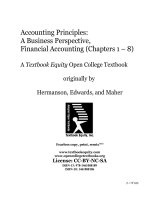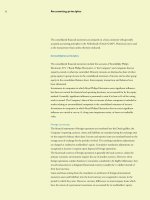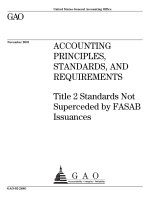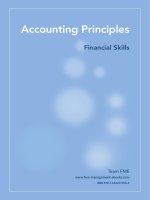Accounting principles
Bạn đang xem bản rút gọn của tài liệu. Xem và tải ngay bản đầy đủ của tài liệu tại đây (236.77 KB, 13 trang )
ASSIGNMENT 2 FRONT SHEET
Qualification
BTEC Level 4 HND Diploma in Business
Unit number and title
Unit 5: Accounting Principles (5038)
Submission date
December 5th 2023
Date Received 1st submission
Re-submission Date
Date Received 2nd submission
Student Name
Student ID
Class
Assessor name
December 5th 2023
Student declaration
I certify that the assignment submission is entirely my own work and I fully understand the consequences of plagiarism. I understand that
making a false declaration is a form of malpractice.
Student’s signature
Grading grid
P3
P4
P5
P6
P7
M2
1
M3
M4
D2
D3
❒Summative Feedback:
Grade:
❒Resubmission Feedback:
Assessor Signature:
Date:
Internal Verifier’s Comments:
Signature & Date:
2
Table of Contents
Task 1: Producing Financial Statements (P3) ...................................................................... 4
Task 2 Analysing and Interpreting Financial Statements (P4) ........................................... 7
Introduction ........................................................................................................................... 7
Conclusion (P5) ..................................................................................................................... 9
Task 3: Budgets (P6) ............................................................................................................. 10
Learn about the benefits and limitations of budgeting (P7) .............................................. 12
References .............................................................................................................................. 13
3
Task 1: Producing Financial Statements (P3)
Financial statements at the beginning of the period
Income statement
Revenue
Tuition fees earned
123.900
Training fees earned
40.000
Total
163.900
Expense
Depreciation expense, Professional library
0
Depreciation expense, Equipment
0
Salaries expense
50.000
Insurance expense
0
Rent expense
33.000
Teaching supplies expense
0
Advertising expense
6.000
Utilities expense
6.400
Total
95.400
RE
68.500
Equity begin
90.000
Owner investment
0
Owner withdrawal
(50.000)
RE
68.500
Equity end
108.500
4
Balance Sheet
Asset
Liabilities
Cash
34.000 Accounts payable
Accounts receivable
0 Salaries payable
Teaching supplies
8.000 Unearned training fees
Prepaid rent
3.000
Prepaid insurance
12.000
Professional library
Accumulated depreciation, professional
library
35.000
Equipment
80.000
Accumulated depreciation, equipment
(15.000)
(10.000)
Equity
Total Liabilities and
147.000 Equity
Total Asset
Transaction 1: December 15th 2022: ABC company owes its emlpoyees $7000
Accounts
Salaries Payable
Salaries Expense
DR
CR
7000
7000
Transaction 2: December 15th 2020: ABC agrees to provide training services.
Provides 30 days of service for a fee of $6000: 6000/30=$200
December 15th 2020 to December 31th 2020 is 17 days: 200*17=$3400
Accounts
Unearned Training fees
Account Payable
DR
CR
3400
3400
December 1st 2020 : ABC purchased equipment for $16,900 by cash
Accounts
Cash
Equipment
DR
CR
16,900
16,900
5
26.000
0
12.500
108.500
147.000
Calculate depreciation expense: (16,900-7,000)/36= 275
Accounts
Depreciation expense
Accumulated depreciation
DR
275
CR
275
Financial statements at the beginning of the period
Icome statement
Revenue
Tuition fees earned
123.900
Training fees earned
43.400
Total
167.300
Expense
Depreciation expense, Professional
library
0
Depreciation expense, Equipment
275
Salaries expense
57.000
Insurance expense
0
Rent expense
Teaching supplies expense
33.000
-
Advertising expense
6.000
Utilities expense
6.400
Total
102.675
Profit
64.625
Equity begin
90.000
Owner investment
0
Owner withdrawal
(50.000)
RE
64.625
Equity end
104.625
6
Balance Sheet
Asset
Liabilities
Cash
17.100 Accounts payable
Accounts receivable
3.400 Salaries payable
Teaching supplies
8.000 Unearned training fees
Prepaid rent
3.000
Prepaid insurance
12.000
Professional library
Accumulated depreciation,
professional library
35.000
Equipment
Accumulated depreciation,
equipment
Total Assets
(10.000)
Equity
26.000
7000
12.500
104.625
96.900
(15.275)
150.125 Total Liabilities and Equity
150.125
Task 2 Analysing and Interpreting Financial Statements (P4)
Introduction
FPT Digital Retail Joint Stock Company (FPT Retail) was established in 2012 in Vietnam, is a
company under FPT Group, owns 2 retail chains: FPT Shop, F.Studio By FPT and 1 company. The
subsidiary is FPT Long Chau Pharmaceutical Joint Stock Company. In 2012, Digital Retail Joint Stock
Company was established, as one of 07 companies under FPT Joint Stock Company. In 2013, FPT
Shop officially reached the milestone of 100 stores. In 2014, FPT Shop reached the milestone of 200
stores in 63 provinces and cities. Become a direct importer of genuine iPhone.
After that, in 2015 FPT Shop achieved the fastest growth compared to other affiliated companies of
FPT Joint Stock Company with revenue increasing by 50% compared to 2014, pre-tax profit increased
by 338.7%. With that success, FPT has had strong development (FPT Retail, 2023).
7
Raw data
Net Sale Revenue
Gross profit
Operating profit
Net profit
Average assets
Shareholders' Equity
Current Assets
Current Liabilities
Inventory
Cost Of Goods Sold
Average Accounts
Receivable
Net Credit Purchases
Average Accounts Payable
Depreciation
Total Liabilities
Total Interest Payments
Profitability
2021
22.494.961.408.082
3.151.513.261.599,00
546.195.520.349
443.898.346.428
10.786.068.729.507
1.679.274.238.761
10.221.931.678.747
9.106.707.790.746
4.930.359.332.607
19.343.448.146.483
2022
30.165.800.756.670
4.703.177.379.257
473.967.863.770
398.074.197.408
10.523.796.935.046
2.049.335.540.169
9.326.797.408.285
8.474.374.694.877
6.483.827.665.529
25.462.623.377.413
1.985.364.755.551
16.239.806.504.638
2.335.742.934.745
585.528.444.388
9.106.794.490.746
132.229.176.761
538.346.191.905
23.909.155.044.491
2.307.356.375.016
887.338.884.656
8.474.461.394.877
231.527.904.809
2021
14,01%
2,43%
1,97%
4,12%
26,43%
Gross Profit Margin
Operating Profit Margin
Net Profit Margin
Return On Assets
Return On Equity
2022
15,59%
1,57%
1,32%
3,78%
19,42%
FPT Retail's Gross Profit Margin increased by about 1.58% compared to 2021. This is a good point
for the business. However, Operating Profit Margin in 2022 will decrease by about 0.86%. Net Profit
Margin also decreased by 0.65%. Return On Assets also decreased by 0.33% and Return On Equity
decreased by 7.01% compared to 2021. These numbers are not down much, but all three items are
down, showing that the company is having problems in its business operations. In summary, FPT
Retail's ability to generate profits in 2022 has been negatively affected.
Liquidity Ratio
2021
1,12
0,58
Current Ratio
Quick Ratio
8
2022
1,10
0,34
The current ratio decreased by 0.02 compared to 2021 and the quick ratio also decreased slightly by
about 0.25. This is not good for the company because it is having difficulty raising capital to pay
short-term debts. In summary of 2022, FPT Retail has lower debt repayment ability than 2021.
Efficiency Ratios
2021
3,92
11,33
6,95
2,09
93,03
Inventory Turnover Ratio
Accounts Receivable Turnover Ratio
Accounts Payable Turnover Ratio
Assets Turnover Ratio
Day's Sales in Invenroty
2022
3,93
56,03
10,36
2,87
92,94
Inventory Turnover Ratio in 2022 increased slightly by about 0.38 but not significantly and Day's
Sales Inventory did not change much so this is stable for FPT Retail. Accounts Receivable Turnover
Ratio increased by 394% and Accounts Payable Turnover Ratio increased by 49% in 2022, which
shows that the business's ability to collect receivables effectively and that the company can also repay
debt and manage cash flow well. Assets Turnover Ratio in 2022 also increased by about 37%
compared to 2021, proving that the company's use of assets in production and business activities is
effective and good for the company.
Solvency Ratios
2021
4,13
0,11
Interest Coverage Ratio
Solvency Ratio
2022
2,05
0,15
FPT Retail's 2022 Interest Coverage Ratio decreases by 2.08 compared to 2021. Solvency Ratio in
2022 also decreases by 0.04 compared to 2021. However, the decrease is not much so it does not have
too much negative impact on FPT Retail.
Conclusion (P5)
FPT Retail's financial situation is generally stable. Regarding Profitability, there is a decrease but not
significantly. Liquidity Ratio is also somewhat reduced. Efficiency Ratios has increased somewhat.
Finally, the Solvency Ratio decreases. The reason for the decline in financial revenue is due to
increased costs. The reason for this decline is that FPT Retail in 2022 will face disadvantages such as
supply chain disruption during the launch of new Apple products, and the purchasing power of
information technology and communications products will decrease sharply due to influence of macro
factors. Financing costs are rising due to rising interest rates and capital market concerns. However,
9
net revenue grew 34% compared to 2021. Despite this, FPT Retail's financial situation in 2022 is
stable. This is good for business.
Task 3: Budgets (P6)
Income Statement Budget
Jan
Feb
Mar
Apr
May
Jun
Sale Unit
350
500
350
400
400
550
Revenue
59.500
85.000
59.500
68.000
68.000
93.500
COGS
Depcreciation
17.500
25.000
17.500
20.000
20.000
27.500
20.833
5.950
20.833
8.500
20.833
5.950
20.833
6.800
20.833
6.800
20.833
9.350
Sale Expense
R&D Expense
Interest
Expense
2.975
4.250
2.975
3.400
3.400
4.675
700,00
641,67
583,33
525,00
466,67
408,33
EBT
11.542
25.775
11.658
16.442
16.500
30.733
Tax Expense
2.308
5.155
2.332
3.288
3.300
6.147
Net Income
9.233
20.620
9.327
13.153
13.200
24.587
Jul
Aug
Sep
Oct
Nov
Dec
500
600
650
750
850
850
85.000
102.000
110.500
127.500
144.500
144.500
25.000
30.000
32.500
37.500
42.500
42.500
20.833
8.500
20.833
10.200
20.833
11.050
20.833
12.750
20.833
14.450
20.833
14.450
4.250
5.100
5.525
6.375
7.225
7.225
350,00
291,67
233,33
175,00
116,67
58,33
26.067
35.575
40.358
49.867
59.375
59.433
5.213
7.115
8.072
9.973
11.875
11.887
20.853
28.460
32.287
39.893
47.500
47.547
10
Loan Payment
Jan
Feb
Mar
Apr
May
Jun
Beginning Debt
120.000
110.000
100.000
90.000
80.000
70.000
Interest
700,00
641,67
583,33
525,00
466,67
408,33
Principal Payment
10.000
10.000
10.000
10.000
10.000
10.000
Ending Debt
110.000
100.000
90.000
80.000
70.000
60.000
Jul
Aug
Sep
Oct
Nov
Dec
60.000
50.000
40.000
30.000
20.000
10.000
350,00
291,67
233,33
175,00
116,67
58,33
10.000
10.000
10.000
10.000
10.000
10.000
50.000
40.000
30.000
20.000
10.000
0
Cash Budget
Jan
Feb
Mar
Apr
May
Jun
Beginning Cash
140.000
177.567
234.020
271.680
315.667
359.700
Total Cash inflow
59.500
85.000
59.500
68.000
68.000
93.500
Sale Expense
5.950
8.500
5.950
6.800
6.800
9.350
R&D Expense
2.975
4.250
2.975
3.400
3.400
4.675
Principal Payment
10.000
10.000
10.000
10.000
10.000
10.000
Interest
700,00
641,67
583,33
525,00
466,67
408,33
Tax Expense
2.308
5.155
2.332
3.288
3.300
6.147
Total Cash Outflow
Ending Cash
Balance
21.933
28.547
21.840
24.013
23.967
30.580
177.567
234.020
271.680
315.667
359.700
422.620
11
Jul
Aug
Sep
Oct
Nov
Dec
422.620
479.307
548.600
624.220
712.447
813.280
85.000
102.000
110.500
127.500
144.500
144.500
8.500
10.200
11.050
12.750
14.450
14.450
4.250
5.100
5.525
6.375
7.225
7.225
10.000
10.000
10.000
10.000
10.000
10.000
350,00
291,67
233,33
175,00
116,67
58,33
5.213
7.115
8.072
9.973
11.875
11.887
28.313
32.707
34.880
39.273
43.667
43.620
479.307
548.600
624.220
712.447
813.280
914.160
Learn about the benefits and limitations of budgeting (P7)
Benefit: Budgets are often used to establish planning and control of key accounts within an
organization. Budgeting also has benefits that can be mentioned such as helping to compile statistics
on business income and expenditure accounts, budgeting helps organizations have a broader view of
the total amount of money available, thereby helping to balance the budget. using revenue and
expenditure accounts and using them more effectively. Using a budget list also helps predict future
risks because making a project list reports in advance whether the business's performance will be good
or not. bad situations help managers prepare plans to handle bad situations that may occur. Another
benefit is helping businesses control spending, helping businesses analyze and supplement reasonable
spending for different goals, thereby helping businesses control spending and avoid waste. In addition,
budgeting also helps businesses make better decisions (HM Hub, 2023).
Limitation: Budgeting also has limitations in that it will lack flexibility in cases of unexpected changes
from external factors such as changing market conditions and will cause loss of efficiency. Budgeting
is also based only on predictions, so budgets can be inaccurate compared to reality. In addition, when
budgets are set too high, it can also cause employees to become exhausted and tired. The final
limitation is that this is a job that requires a lot of time and effort to budget, while that resource could
be used for more important things, so this is a time-consuming job (HM Hub, 2023).
12
References
FPT Retail. (2023) Giới thiệu, [ONLINE] Available from: [Accessed 22
November 2023].
HM Hub. (2023) Advantages & Disadvantages of Budgeting, [ONLINE] Available from:
[Accessed 3 December 2023].
13









